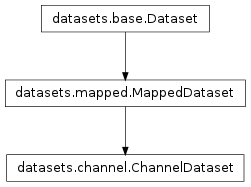This content refers to the previous stable release of PyMVPA.
Please visit
www.pymvpa.org for the most
recent version of PyMVPA and its documentation.
datasets.channel
Module: datasets.channel
Inheritance diagram for mvpa.datasets.channel:

Dataset handling data structured in channels.
-
class mvpa.datasets.channel.ChannelDataset(samples=None, dsattr=None, t0=None, dt=None, channelids=None, **kwargs)
Bases: mvpa.datasets.mapped.MappedDataset
Dataset handling data structured into channels.
Channels are assumes to contain several timepoints, thus this Dataset
stores some additional properties (reference time t0, temporal
distance of two timepoints dt and channelids (names)).
See also
Please refer to the documentation of the base class for more information:
MappedDataset
Initialize ChannelDataset.
| Parameters: |
- samples (ndarray) – Three-dimensional array: (samples x channels x timepoints).
- t0 (float) – Reference time of the first timepoint. Can be used to preserve
information about the onset of some stimulation. Preferably in
seconds.
- dt (float) – Temporal distance between two timepoints. Has to be given in
seconds. Otherwise samplingrate property will not return
Hz.
- channelids (list) – List of channel names.
- mapper (Instance of Mapper) – This mapper will be embedded in the dataset and is used and
updated, by all subsequent mapping or feature selection
procedures.
- data (dict) – Dictionary with an arbitrary number of entries. The value for
each key in the dict has to be an ndarray with the
same length as the number of rows in the samples array.
A special entry in this dictionary is ‘samples’, a 2d array
(samples x features). A shallow copy is stored in the object.
- dsattr (dict) – Dictionary of dataset attributes. An arbitrary number of
arbitrarily named and typed objects can be stored here. A
shallow copy of the dictionary is stored in the object.
- dtype (type | None) – If None – do not change data type if samples
is an ndarray. Otherwise convert samples to dtype.
|
|---|
-
channelids
List of channel IDs
-
dt
Time difference between two samples (in seconds).
-
resample(nt=None, sr=None, dt=None, window='ham', inplace=True, **kwargs)
Convenience method to resample data sample channel-wise.
Resampling target can be specified by number of timepoint
or temporal distance or sampling rate.
Please note that this method only operates on
ChannelDataset and always returns such.
| Parameters: |
- nt (int) – Number of timepoints to resample to.
- dt (float) – Temporal distance of samples after resampling.
- sr (float) – Target sampling rate.
- inplace (bool) – If inplace=False, it would create and return a new dataset
with new samples
- **kwargs – All additional arguments are passed to resample() from
scipy.signal
|
|---|
| Return : | ChannelDataset
|
|---|
-
samplingrate
Yeah, sampling rate.
-
substractBaseline(t=None)
Substract mean baseline signal from the each timepoint.
The baseline is determined by computing the mean over all timepoints
specified by t.
The samples of the dataset are modified in-place and nothing is
returned.
| Parameters: | t (int | float | None) – If an integer, t denotes the number of timepoints in the from the
start of each sample to be used to compute the baseline signal.
If a floating point value, t is the duration of the baseline
window from the start of each sample in whatever unit
corresponding to the datasets samplingrate. Finally, if None
the t0 property of the dataset is used to determine t as it
would have been specified as duration. |
|---|
-
t0
Temporal position of first sample in the timeseries (in seconds) – possibly relative to stimulus onset.


